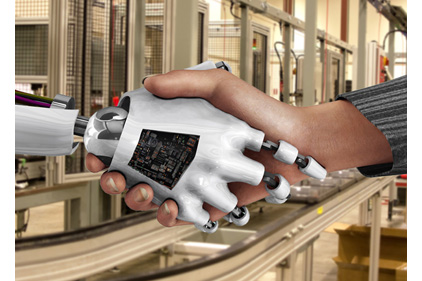New technology allows robots and humans to work closer than ever. But, several hurdles remain before there will be widespread deployment on assembly lines.
“First and foremost, there needs to be a greater awareness and better understanding of how collaborative robots operate,” warns Eric Foellmer, marketing and communications manager at Rethink Robotics Inc., which recently launched a collaborative robot called Baxter. “When people generally picture an industrial robot, they think of a very high speed machine moving with incredible precision or lifting very heavy objects.
“But, collaborative robots are different products, with different skill sets,” explains Foellmer. “Because they are designed to be safe, collaborative robots don’t operate with the same ultra-high speed of their industrial counterparts. They don’t generate the torque necessary to lift large, heavy objects.” Indeed, each of Baxter’s two articulated arms can only lift 5-pound payloads at the moment.
“There are different robots, with different benefits, performing different functions in a plant,” Foellmer points out. “As they continue to be more readily adopted throughout the manufacturing world, and their safety, flexibility and rapid ROI become more well understood, you’ll continue to see a lot more [collaborative] types of robots showing up on production lines everywhere.’”
“Besides safety issues, we need systems that offer a high ROI to see collaborative robots spread on assembly lines,” adds Martin Naumann, group manager in the robot and assistive systems department at the Fraunhofer Institute for Manufacturing Engineering and Automation. “To achieve the required high utilization in assembly, it is crucial that collaborative systems offer the flexibility to be adapted to and used for many jobs in an assembly line.
“Besides intuitive programming, it is therefore crucial to develop flexible part supply and gripper-tooling solutions,” says Naumann, who is in charge of the European Union’s Lean Intelligent Assembly Automation (LIAA) project. “This is one of the challenges [we] are working on in parallel to LIAA.”
The four-year LIAA project, brings together leading European research institutes, automation component and robot suppliers, technology providers and end users, kicked off in September 2013. The overall objective of LIAA is to develop cost-effective collaborative robot systems for assembly applications.
“Specific solutions will be developed for the design of safe collaborative work places, shop floor programming of the robot, and intuitive interaction of robot and worker,” says Naumann. “In the end, the resulting robot system should significantly increase the productivity of current manual assembly work places and relieve [humans] of tedious and non-ergonomic jobs.”






